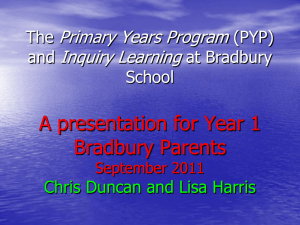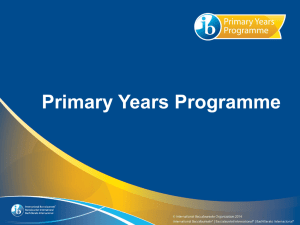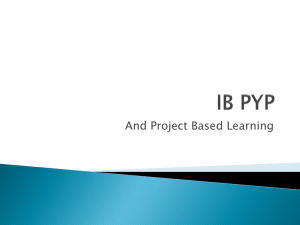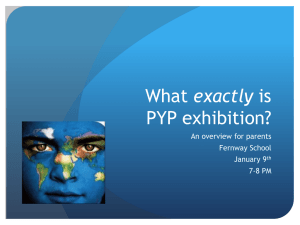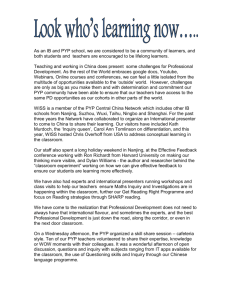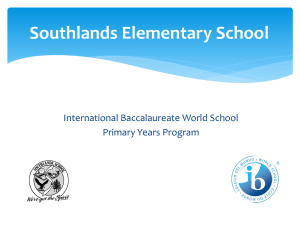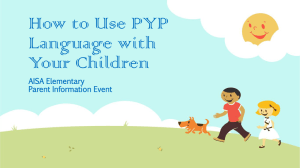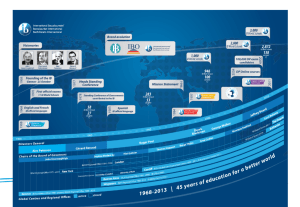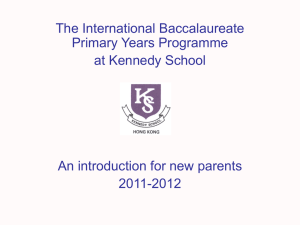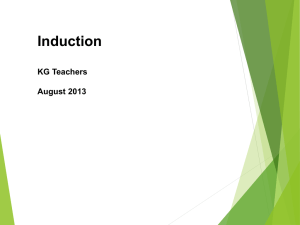PYP Understanding Questionnaire
advertisement
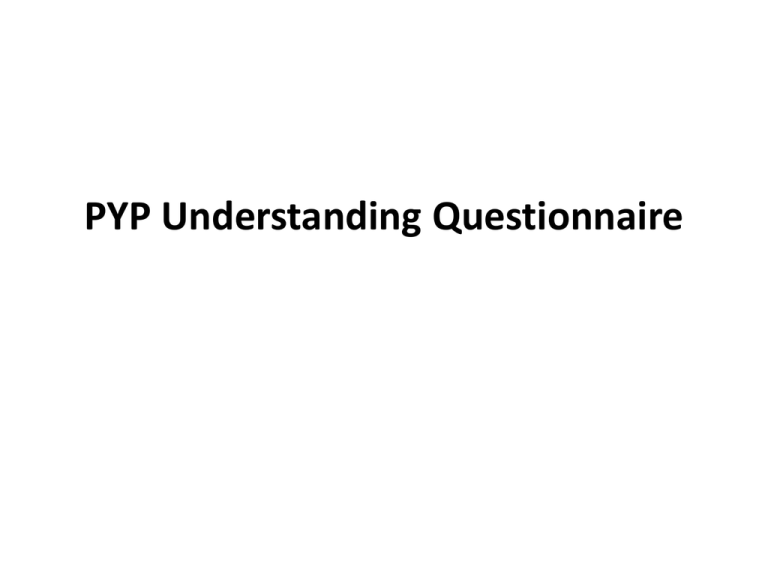
PYP Understanding Questionnaire What are the underlying ideas of the PYP? – International mindedness – Whole child – Lifelong learner – Inquiry – Real life What is your understanding of the international dimensions of the programme? • The aim of all IB programmes is to develop internationally minded people who, recognizing their common humanity and shared guardianship of the planet, help to create a better and more peaceful world. • An internationally minded person is a person who demonstrates the attributes of the IB learner profile. How do we learn? • By linking new knowledge with existing knowledge • Therefore: – Uncovering learners’ prior knowledge and current understanding is essential for effective facilitation of learning. – The experiences, interests and needs of individual learners should inform planning, teaching and assessment. • This is Social Constructivism What are the essential elements of curriculum? – Knowledge: what do we want students to know about? – Concepts: what do we want students to understand?* – Skills: what do we want students to be able to do? ** – Attitudes: what do we want students to feel, value and demonstrate? – Action: how do we want students to act? * The big ideas **Think: What transdiciplinary skills does the pyp suggest? How are they different from discipline skills? What is at the heart of PYP curriculum model? • Learners Constructing Meaning What are the features of PYP curriculum model? • Learner is at the center, • prior knowledge is important, • children are NOT empty vessels to be taught “at”, • curriculum is not only written, • the cycle is iterative, etc. The PYP curriculum is concept-driven trans-disciplinary inquiry-based What does concept-driven mean? • We want to learn the concepts not ‘topics’. • We use the Key Concept questions (p.18-20) to formulate questions for exploring the concept. • Then note what knowledge they will need to acquire in order to answer those questions. • The conceptual focus comes first in planning, and the knowledge then informs the inquiry in an authentic and meaningful manner – but it does not drive the inquiry or the curriculum. • See pp. 98-101, and 108-110. Read pp. 15-17 to consolidate. What does trans-disciplinary mean? • Transdisciplinarity means the subjects are used together as lenses for developing thinking and learning, and Scope and Sequences (disciplinary knowledge and skills) and resources can then be mapped to the PoI as is relevant to uncovering the central ideas (concepts). (rather than the other way around). • Refer to “Developing a TD PoI” as a resource. P. 9 Fig 3. What does inquiry mean and why is it important? • Inquiry is the means by which self-motivated learning takes place in real life. Inquiry directly supports the personal construction of meaning and active responsible learning: effective learning is collaborative and social. • An inquiry driven curriculum facilitates/promotes the use of a range and balance of teaching strategies to meet specific individual learning needs. What is Program of Inquiry? How is it developed? • It is the collection of all the units taught throughout the school. • It includes the central ideas, lines of inquiry, subject focus, key concepts of each unit • It is not the only component of PYP • It is developed through collaborative meetings by all the teachers What is your school’s adopted Inquiry Cycle? How do you explain each of the attributes of the learner profile to your children? • Inquirers They develop their natural curiosity. They acquire the skills necessary to conduct inquiry and research and show independence in learning. They actively enjoy learning and this love of learning will be sustained throughout their lives. • Knowledgeable They explore concepts, ideas and issues that have local and global significance. In so doing, they acquire in-depth knowledge and develop understanding across a broad and balanced range of disciplines. • Thinkers They exercise initiative in applying thinking skills critically and creatively to recognize and approach complex problems, and make reasoned, ethical decisions. • Communicators They understand and express ideas and information confidently and creatively in more than one language and in a variety of modes of communication. They work effectively and willingly in collaboration with others. • Principled They act with integrity and honesty, with a strong sense of fairness, justice and respect for the dignity of the individual, groups and communities. They take responsibility for their own actions and the consequences that accompany them. • Open-minded They understand and appreciate their own cultures and personal histories, and are open to the perspectives, values and traditions of other individuals and communities. They are accustomed to seeking and evaluating a range of points of view, and are willing to grow from the experience. • Caring They show empathy, compassion and respect towards the needs and feelings of others. They have a personal commitment to service, and act to make a positive difference to the lives of others and to the environment. • Risk-takers They approach unfamiliar situations and uncertainty with courage and forethought, and have the independence of spirit to explore new roles, ideas and strategies. They are brave and articulate in defending their beliefs. • Balanced They understand the importance of intellectual, physical and emotional balance to achieve personal well-being for themselves and others. • Reflective They give thoughtful consideration to their own learning and experience. They are able to assess and understand their strengths and limitations in order to support their learning and personal developmnt. How do you explain each of the Attitudes to your children? Appreciation Appreciating the wonder and beauty of the world and its people. Commitment Being committed to their own learning, persevering and showing selfdiscipline and responsibility. Confidence Feeling confident in their ability as learners, having the courage to take risks, applying what they have learned and making appropriate decisions and choices. Cooperation Cooperating, collaborating, and leading or following as the situation demands. Creativity Being creative and imaginative in their thinking and in their approach to problems and dilemmas. Curiosity Being curious about the nature of learning, about the world, its people and cultures. Empathy Imagining themselves in another’s situation in order to understand his or her reasoning and emotions, so as to be open-minded and reflective about the perspectives of others. Enthusiasm Enjoying learning and willingly putting the effort into the process. Independence Thinking and acting independently, making their own judgments based on reasoned argument, and being able to defend their judgments. Integrity Being honest and demonstrating a considered sense of fairness. Respect Respecting themselves, others and the world around them. Tolerance Being sensitive about differences and diversity in the world and being responsive to the needs of others. What is good PYP practice: the role of teacher and student? • Classroom: – – – – – – – • Students: – – – – – • Lively Collaborative and purposeful activities Reflective place High expectations With boundaries and structure Respectful and supportive Have resources Actively engaged in planning and assessing their own learning Supportive of each other Moving from group work to individual work Changing roles: partner, leader, member of the whole group Asking questions Teachers: – – – – – – Use variety of teaching and assessment strategies and use of resources Responsive to the needs and interests of individual students Facilitate connection between previous and new knowledge Balance in attention given to knowledge, skills, attitudes, attributes Encourage students to take responsibility Ask good opne-ended questions How do we differentiate? • Method of teaching e.g. open ended tasks, freedom of choice, evidence of reasoning • Content e.g. complexity, variety • Grouping e.g. paired tutoring, whole-class, role-allocation (like literature circle), individual work What resources are available in the school to facilitate inquiry-based learning? • • • • • Library Resources room Art room ICT Setting of the classes: tables and chairs, no stage, displays, etc What assessment structures are in place at the school? – Assessing: how do we discover what students have learned? – Recording: how do we collect and analyze the data? – Reporting: how do we choose to communicate information about assessment? What are some of the items in your activity toolbox? 1. 2. 3. 4. 5. 6. 7. 8. 9. 10. 11. 12. 13. 14. 15. 16. 17. 18. Essential agreement think, pair, share KWL chart Bus stop Word sort Clapping game Mixer Diamond ranking Differentiation quadrants Circle time (talk about the lesson of the day, Calendar, etc) Reader’s Theater Literacy circle Word maps Mini lessons Conferencing Journal Burke’s reading and writing interview Novel Studies 1. 2. 3. 4. 5. 6. 7. 8. 9. 10. 11. 12. 13. 14. 15. 16. 17. 18. Story Plan; story settings Book report Concentric circles Sentence starters Wandering wall Workshop Time Popcorn pictures Talk parachute Models The shout out box Y chart Centers in the classroom Paper-pass Presentations – more than showing their work Categorizing Puppets Job shadowing Reading for children What are some of the tenets of your school’s essential agreement? When and how was it developed? Is it based on PYP attitudes? When and how was the essential agreement of your class developed? Are they based on PYP attitudes? When and how was your school’s goal of the year developed? How has the programme impacted upon the students, the teaching staff and the administration? • The school has turned into a community of learners • There is the evidence, in classrooms and in records of student work, of inquiry-based learning, and of both independent and collaborative work. • the collaboration on the part of all the PYP teachers is high, and there is a commitment to the transdisciplinary model • students are encouraged to be curious, be inquisitive, ask questions, explore and interact with the environment physically, socially and intellectually • students are supported in their struggle for mastery and control on their journey to become independent, autonomous learners • the learning experiences are differentiated to accommodate the range of abilities and learning styles in the group • Administrators are highly involved in teaching and learning The things they wanted us to work on in our teaching and learning • Broader range of teaching strategies • Strengthen understanding and use of assessment strategies and tools • Differentiation for stronger and weaker students • Use inquiry across curriculum • Facilitate groups and regrouping of students for a variety of learning situations • Allow students to become actively responsible for their own learning, and to learn how to reflect on their experiences and make more informed independent choices • Deepen the understanding of students’ perspective on a global level, extending their understanding beyond the context of Iran. • Pastoral care
